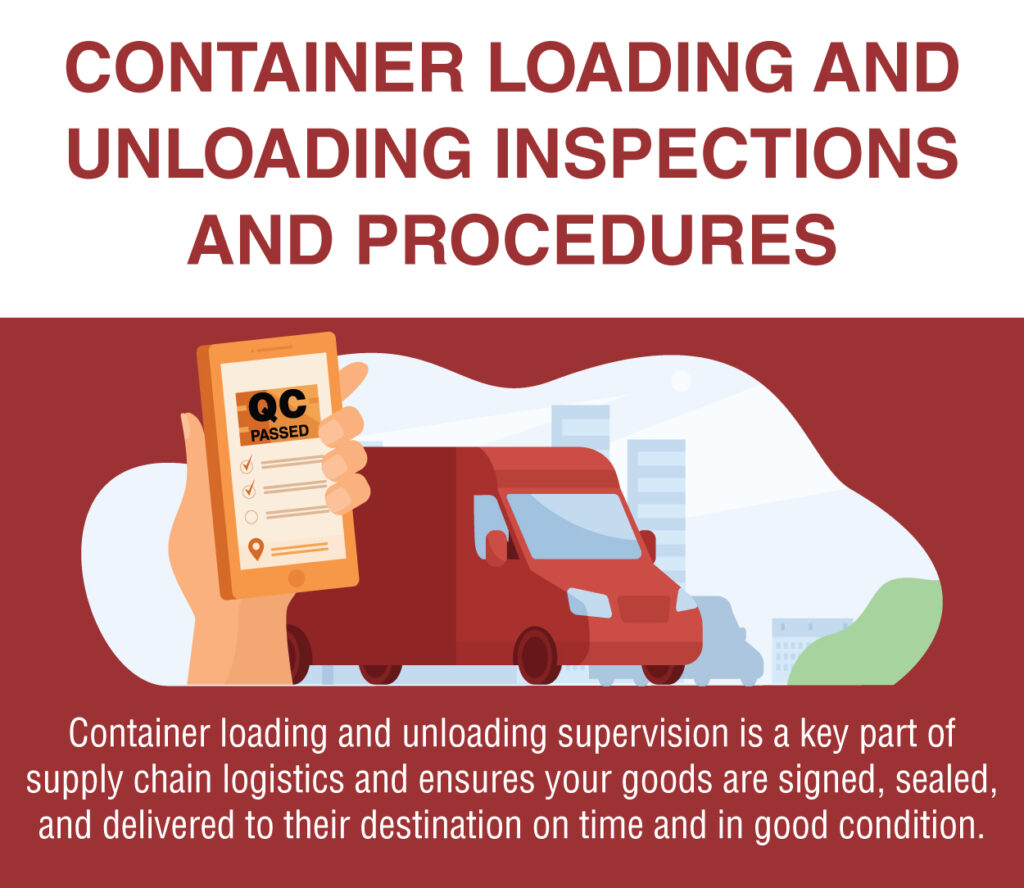Container loading and unloading supervision is a key part of supply chain logistics and ensures your goods are signed, sealed, and delivered to their destination on time and in good condition. But a container loading often involves much more than what you may think. This article will go through some key procedures of loading and unloading containers.
What Is Container Loading Inspection?
A container loading inspection typically takes place at the shipper’s factory or warehouse and is carried out to ensure the goods are handled correctly and safely when being loaded into the shipping containers. Thereby ensuring the container has been loaded, unloaded, and inspected according to international safety, security, and quality standards to reduce the risks of the products being harmed or problems at the borders.
Check our free container inspection report sample to learn how the process is documented.
|
How Is Container Loading Calculated?
Containers can often offer a shipping method for small businesses that can reduce the chances of theft and help keep the shipping load together as a single unit, minimizing the likelihood of cargo parts going missing when shipped in large boxes.

Business owners using container transportation often need to estimate:
- The size of the cargo.
- Select the correct container for the load.
- Determine how to pack it to ensure it meets the shipper’s requirements.
- Make the most use of the container’s space.
Firstly, the number of boxes should be counted, and each box should be measured in length, width, height, and weight. All measurements should be noted.
- Large upright packing bags should also be measured by length, width, height, and weight.
- Barrels, whether made of metal or plastic, should be measured by diameter, height, weight, and quantity.
- Metal or plastic barrels should be measured by diameter, height, weight, and quantity.
- Loaded bags should stand freely on the floor.
- Large upright packing bags should also be measured by length, width, height, and weight.
Aside from those items mentioned earlier, all load items for the same customer should be grouped together, and all pallets should be measured. Any items identified as substances controlled under Hazmat regulations need to be grouped together. The pallet space should be measured by length, width, and height. The shipper should be contacted and given all of the measurements.
What Percentage of Containers Are Inspected?
The percentage of inspected containers can vary in different places, depending on the traffic volume. For example, in large global ports where many containers are moved, the percentage can be below 1%. However, most of the time, the vast majority of regularly shipped cargoes and containers are industrial goods coming from one trusted shipper to another trusted importer. Therefore, these will have already been pre-cleared by trusted parties at their source. The number of customs officers and machines needed at all terminals operating 24 hours a day would be enormous, which is why boxes tend to be mostly spot-checked.
What Is a Loading Supervision?
Loading supervision is a process in which an inspector ensures that the workers are loading and unloading containers and the products following safety, security, and other relevant loading procedures. It takes place when the workers are loading the goods into the container. The inspectors will monitor the entire process, including a condition evaluation of the shipping container and verification of product information, shipment quantities, packaging suitability, and overall supervision of the loading process.
Once the container is loaded, a branded seal is applied to the container to reduce the potential risk of product substitution after loading.
Loading Container Procedures
The container loading process starts with a container inspection. If the container is in good condition and the goods are 100% packed and confirmed, the warehouse loading and unloading procedure continues. The inspector verifies that the correct goods were packed and that all the client’s specifications were met. Once the loading and unloading of the container commences, the inspector verifies that the correct unit amount is being loaded.
Procedure
- Record the weather conditions, the arrival time of the container, container number, and truck number.
- Check the inner and outer condition of each container to assess the damage, wellness, perforation, smell and marks, etc.
- Check the number of goods loaded and record the condition of outer packaging (master cartons/pallets).
- Randomly select and open sample cartons to verify compliance with customer’s specifications.
- Supervise the loading process to minimise breakage and maximise space utilisation.
- Seal the container with the custom seal and AQM BD seal.
- Record the seal numbers and departure time of containers.
Unloading a Container Procedure
By sealing the container with a tamper-evident seal, the client can rest assured that there’ll be no outside meddling with their products after the loading supervision has been completed. The whole container opening process will be witnessed when the goods arrive at the destination.
Loading and unloading inspection reports include the number of goods, container condition, process, and procedure used for container uploading. Furthermore, photos will document all steps of the loading and unloading supervision process.
Before beginning the container unloading methods, the inspector needs to check the container’s structural stability and that no sign of damage has occurred by testing the locking mechanisms and inspecting the shipping container exterior. Once the container inspection has been completed, the inspector will issue the container loading and unloading inspection report.
Procedure
- Record the arrival time of the container at the destination.
- Witness the container opening process.
- Check the validity of the unloading documents.
- Check the amount, packing, and marking of the goods.
- Supervise unloading to see if the goods are damaged during these processes.
- Check the cleanliness of the unloading and shipment area.
What Does Container Unload Mean?
With container loading, you need to ensure that when the containers arrive at their destination they will be unloaded and handled in the correct manner. Throughout the unloading process an inspector will check all the goods and ensure they are handled with care. The quality and condition of your goods and packaging are checked as well as the documentation.
How Long Do You Get To Unload a Container?
It varies depending on the size of the container and any container loading and unloading supervision starts with a container inspection. If the container is in good condition and the goods are 100% packed and confirmed, then the loading and unloading inspection process continues. The inspector verifies that the correct goods were packed and that all the client’s specifications were met. While the loading and unloading of the container commences, the inspector verifies that the correct unit amount is being loaded and unloaded.
Why Loading of Container and Unloading Inspections Are Important
As an importer, your goods need to arrive in perfect condition. However, many things can go wrong during the loading process or shipment.
These issues include:
- Wrong quantity of goods in the container.
- Incorrect usage of packaging and labeling.
- The packages are not sealed and mounted correctly.
- Damaged goods or crushed/bulged packages.
Container inspections are vital because handling shipping containers can result in problems that could impact the quality of your goods during transportation. Some suppliers enforce particular methods on their employees that can result in poorly packed containers, increasing costs, or compensating for damaged goods. The inspection process can help you mitigate these issues, saving you time, annoyance – and money from less damaged goods.
Conclusion: Container Loading and Unloading Inspections and Procedures
The container loading and unloading inspections and procedures are integral to reducing damaged goods and ensuring that they are in good condition when they arrive at the final destination.
At AQM BD, we can help ensure your goods are transported safely. We are one of the world’s industries leading quality assurance services companies and can offer our services across 40+ regions worldwide. Learn more about our container loading inspection services and pre shipment inspection and quality control services today.





